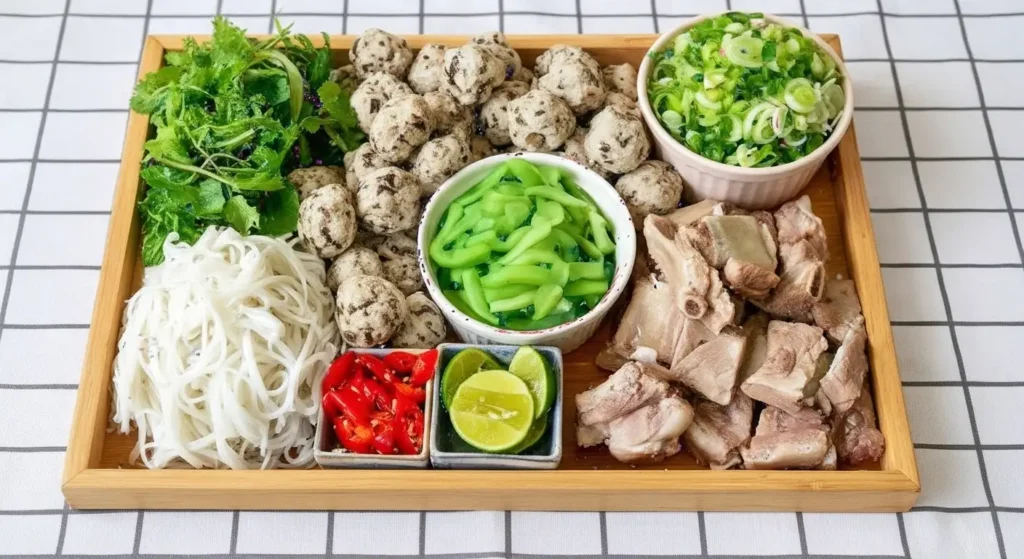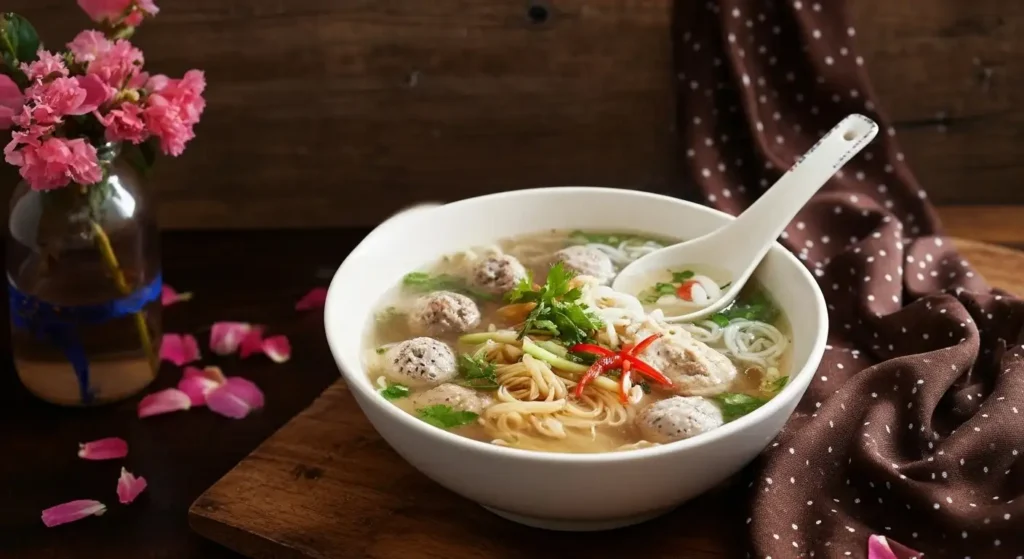Bún Mọc (pronounced boon mawk) is a beloved Vietnamese noodle soup known for its light, clear, yet richly flavored broth, and its variety of tender pork toppings. It’s a classic example of Northern Vietnamese cuisine that has traveled across the country, offering a gentle, comforting alternative to bolder, spicier noodle soups.
The Basics of Bún Mọc
What is it?
Bún means “rice vermicelli noodles,” and Mọc refers to the specific type of savory pork paste or meatball that is the signature component of the dish.
It is a comforting soup built on a foundation of thin, delicate rice vermicelli noodles submerged in a clear, savory pork-based broth.
Origin:
Bún Mọc originated from Mọc Village (Làng Mọc) in Nhân Chính, Thanh Xuân, Hanoi (Northern Vietnam). It is a quintessential Hanoi dish.
The Broth:
Unlike the highly concentrated broths of Phở or Bún Bò Huế, the Bún Mọc broth is renowned for its clarity and subtle sweetness. It is typically simmered with pork bones, often with the addition of shiitake and wood ear mushrooms and dried young bamboo shoots (măng), which impart a distinctive, earthy, and clean flavor.
Flavor Profile:
The overall flavor is gentle, savory, and pure, making it a perfect everyday meal. It relies on the freshness of the ingredients and the quality of the pork, rather than aggressive spices.

The Varieties of Pork Toppings (Mọc)
The beauty of Bún Mọc lies in its diverse and tender pork components, which give the soup its body and flavor. A typical bowl is a medley of textures:
| Topping Category | Vietnamese Name | Description |
|---|---|---|
| The Signature Meatball | Mọc (Pork Balls) | The essential ingredient. These are small, bouncy meatballs made from raw pork paste (giò sống) mixed with finely chopped wood ear mushrooms and sometimes glass noodles. They are cooked directly in the broth. |
| Pork Sausage | Chả Lụa / Giò Lụa | Steamed Vietnamese pork sausage, often sliced and floating in the soup, providing a smooth, tender texture and a pure pork flavor. |
| Cinnamon Pork Sausage | Chả Quế | Pork sausage seasoned with cinnamon, adding a warm, aromatic element to the bowl. |
| Pork Ribs | Sườn (Pork Ribs) | Tender pieces of young pork ribs (sườn non) are often simmered in the broth and served in the bowl, offering a rich, fall-off-the-bone texture. |
| Additional Garnishes | Măng Khô (Dried Bamboo) | Dried bamboo shoots, rehydrated and cooked in the broth, add an earthy, slightly chewy component. |
| Hành Phi (Fried Shallots) | A generous sprinkle of golden-brown crispy shallots on top is crucial for an added layer of aroma and crunch. |
How to Enjoy Bún Mọc
Bún Mọc is served piping hot and, like most Vietnamese noodle soups, is highly customizable at the table.
Preparation is Key: The bowl arrives with the bún noodles, a medley of pork toppings (mọc, chả lụa, ribs), and the clear broth, all garnished with chopped scallions, cilantro, and crispy shallots.
Adjusting the Flavor: While the broth is delicious on its own, it’s customary to season it to your personal taste. Common additions include:
A dash of fish sauce (Nước Mắm) for extra saltiness and depth.
A squeeze of lime or kumquat for a hint of tanginess.
Chili sauce, fresh sliced chili, or chili oil for heat.
Optional: A very small dab of fermented shrimp paste (Mắm Tôm) is sometimes used by purists in the North to add a deep layer of umami, but use sparingly as it has a very strong flavor.
Mixing and Eating: Use chopsticks to stir the noodles, meat, and herbs, ensuring the added condiments are integrated into the broth. Enjoy the soup and noodles in alternating bites, making sure to savor the different textures of the various pork toppings.
Vegetables: Unlike dry noodle dishes, Bún Mọc is typically served with a smaller side plate of fresh herbs and bean sprouts. These are added directly into the hot soup to lightly wilt before eating, adding a refreshing crunch.

Regional Differences in Bún Mọc
As a dish strongly rooted in the North, Bún Mọc retains much of its original character throughout Vietnam, but subtle shifts occur in the Central and Southern regions.
| Region | Regional Characteristics and Variations | Key Differences |
|---|---|---|
| Northern Vietnam (Hanoi) | The Original Style. The emphasis is on the clarity and lightness of the broth, with the earthy flavor of dried bamboo shoots and mushrooms being prominent. The soup is balanced, favoring savory and pure flavors over excessive sweetness or spice. | Toppings are standard: Mọc (pork balls), Chả Lụa, and often pork ribs. Broth seasoning is minimal, often finished with a tiny bit of Mắm Tôm (shrimp paste) on the side for dipping the meat. |
| Central Vietnam | Spicier and More Broth-Focused. Central Vietnamese cuisine is known for its bold, spicy, and often richer preparations. While Bún Mọc is not a native Central dish, it is enjoyed with an added layer of complexity. | Diners are more likely to add a generous amount of chili paste/oil. The broth may sometimes be slightly richer or contain more localized herbs than the Northern version. |
| Southern Vietnam (Ho Chi Minh City) | Richer and Sweeter Broth. In the South, where palates often prefer a sweeter touch, the pork broth is typically richer and sweeter from the bone-simmering process. Portions also tend to be larger. | Southern bowls are often generous and include a wider variety of optional toppings, such as quail eggs or sometimes even fried ingredients. The broth is often pre-seasoned to be slightly sweeter than the Northern original. |




